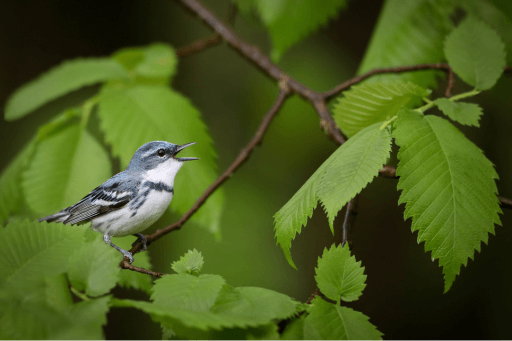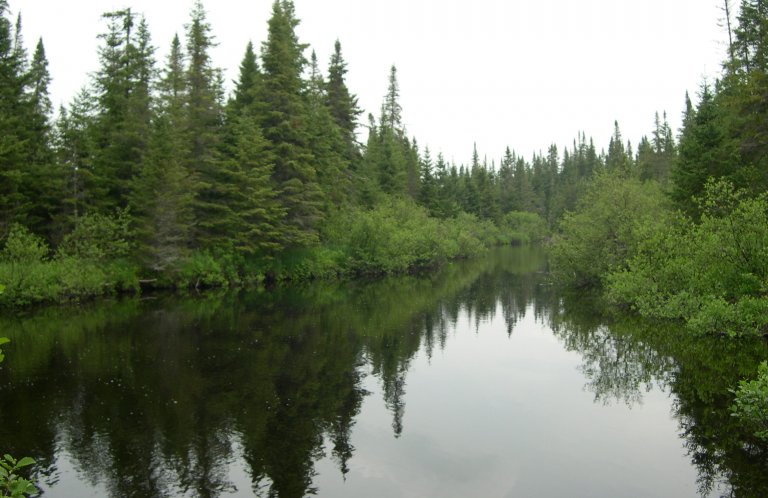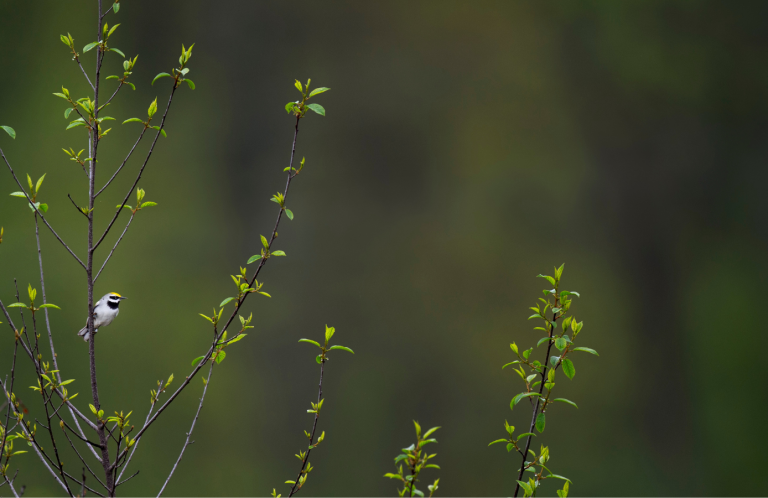Temperate Forests: Conserving Vital Bird Habitat in Any Season
This is part of a series of explorations of different kinds of forest biomes found throughout the Western Hemisphere – and how American Bird Conservancy works to conserve them as vital bird habitats. Click to read about tropical forests, boreal forests, and different ages of forests.
Life in temperate forests, located midway between the equator and the North or South Pole, changes with the seasons, with plants and animals having evolved to endure cold and snowy winters, sticky and hot summers, and everything in between. This is precious habitat for birds. Temperate forests sustain and support year-round residents, nesting migratory birds, and fleeting visitors who stop briefly as they migrate.
One such brief visitor is the Blackpoll Warbler. After spending its non-breeding season in the tropical forests, this little songbird begins a long journey northward. The deciduous forests of the temperate zone are a rest stop for the Blackpoll Warbler, but they are barely the halfway point. After a day or so of rest and a chance to refuel, this long-distance migrant is once again on its way toward its breeding grounds in the boreal forest.
“Leaf” It Behind

Deciduous forests erupt in a riot of color every fall in the northern United States as oak, maple, beech, and birch trees prepare for the coming winter. This spectacular display sets deciduous trees apart: to conserve energy during the winter season, they will shed their leaves and enter a period of dormancy. In the spring and summer, the songs of migratory birds like the Wood Thrush and Cerulean Warbler ring out from the deciduous forests of the eastern U.S. Keeping these species singing is the focus of ABC's work in the Poconos BirdScape.
ABC's BirdScapes approach conserves key habitats throughout the annual cycle of target species, ensuring that migratory birds have high-quality habitat on their breed and non-breeding grounds and at important stopover points in between. Each BirdScape is unique and influenced by local conditions. In the Poconos BirdScape, ABC partners with government agencies, universities, and private landowners to manage forests with the needs of target species such as the Wood Thrush and Cerulean Warbler in mind. Our goal is to ensure that at least 37,000 acres provide optimal habitat conditions for these species. The results have a ripple effect: once the leaves have fallen and Neotropical migratory birds have flown south, the forest is still teeming with birdlife. Year-round residents like the Ruffed Grouse and Great Horned Owl can brave the winter months in a quality habitat in the Poconos BirdScape.
Trees Built for Winter

The trees that make up coniferous forests handle the swing of the seasons differently: they have needles rather than leaves and cones instead of flowers. These evergreen trees are adapted for periods of intense cold and snow or prolonged dryness. Jack Pine thrives in dry, sandy soils left by retreating glaciers in the Great Lakes region. They may look a bit scraggly, but to the Kirtland's Warbler, they look just right. When it comes to nesting Kirtland's Warblers, only Jack Pines will do — and only younger Jack Pine trees, at that.
Jack Pine forests historically experienced periodic natural wildfires that encouraged the growth of new trees by burning and clearing mature trees, with the heat from wildfires releasing seeds from cones. With the suppression of natural wildfire came a precipitous decline in breeding habitat for Kirtland's Warblers. Careful management of Jack Pine forests, including the use of managed burns and timber harvests, helped restore the habitat and reverse the freefall of the Kirtland's Warbler population. Though they may lack the showy display of a deciduous forest, coniferous forests are every bit as active — and vital.
“The near-extinction of the Kirtland's Warbler from habitat loss was a learning experience for conservationists,” said Steve Roels, Kirtland's Warbler Program Director & Conservation Team Coordinator for ABC. “Simply designating large forested areas as protected habitat was insufficient because the Kirtland's Warbler, like other young forest specialists, additionally needs the right forest structure within those big blocks of habitat. We can celebrate the recovery of the Kirtland's Warbler today because we developed tools to effectively manage the Jack Pine forest and sustain those efforts year after year.”
ABC and partners are working to conserve at least 36,000 acres for the Kirtland's Warbler and other species that share its specialized habitat.
A Rainforest with Range
While they experience seasons and are cooler than their tropical counterparts, temperate rainforests also have continuous canopy cover, with trees like the soaring Sitka Spruce, Douglas Fir, and Western Hemlock rising along the western coasts of the northern United States and Canada. In Chile and Argentina, the Valdivian forests that remain as a thin strip along the coast are made up of incredibly long-lived trees like the ancient alcerce. True to their name, temperate rainforests experience a high level of precipitation, with some areas of the Pacific rainforests receiving as much as 10 feet of rainfall annually.
In these damp, mossy forests in the Pacific Northwest, you might be lucky enough to spot the Endangered Marbled Murrelet, a tiny seabird with an unusual reliance on trees. This quail-sized bird looks well suited to life in the water and uses its short, blunt wings like rudders to dive up to 50 meters into the sea. Surprisingly, those stubby wings also help it fly as far as 50 miles inland to nest, often in the tall trees found in coastal temperate rainforests. Looks can be deceiving! The sky-high nesting habits of Marbled Murrelets remained a mystery well into the 1970s.
Along with wildfire, the logging of old-growth forests remains one of the most concerning threats to the species. Unlike the cyclical fire that is needed to make way for new Jack Pines to grow, wildfires in the temperate rainforest are rare and often catastrophic events, caused by human acts or random events like lightning strikes. A lesser-known threat is nest predation by corvids, such as the Common Raven, which are attracted to nesting areas by the availability of food at nearby campsites. Through the “Crumb Clean” campaign, ABC and partners are working to keep these forest habitats free of food waste — and safer for nesting murrelets.
Boreal Bound
Stay tuned for our next piece on forest habitats as we trace the Blackpoll Warbler's path to the boreal forests of North America. Hundreds of bird species nest and raise their young in this great forested expanse each year, earning the boreal forest the nickname of “North America's bird nursery.”
This is part of a series of explorations of different kinds of forest biomes found throughout the Western Hemisphere – and how American Bird Conservancy works to conserve them as vital bird habitats. Click to read about tropical forests, boreal forests, and different ages of forests.



















































